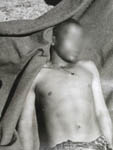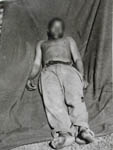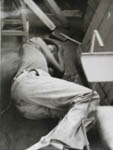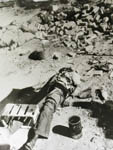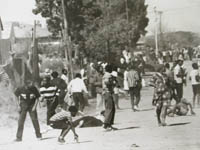Table of Contents
Acknowledgments Readers' Guide
Introduction The Narrative Official Stories The Participants Afrikaans Memory and Violence Final Thoughts Archive
Abbreviations Glossary
Gutenberg-e.org Columbia University Press
Chapter 6
"I Saw a Nightmare …:" Violence and the Construction of Memory
On Violence and the Body: The Dead
Sometimes the cool language of historical analysis seemed unequal to the task of adequately describing or understanding the events for which even ordinary language lacks a vocabulary. We cannot recuperate the voices of those who were silenced by death. And often words do not seem adequate to describe the pain of Soweto. Moreover, words fail completely before the callousness with which those who committed the violence treated the memory of their victims. For example, Sophie Tema described the death of the first victim of police fire:
We saw a boy who had an overall on, carrying another boy in his arms and a girl next to him. She was crying, weeping, and they were coming towards us.1730
The man who fired the first shots tried to deny any knowledge of his victim:18
Kleingeld: Nee, ek weet nie wie Hector Petersen is nie, of hy maar later nou net vir die doel gebruik is waarvoor hy wel gebruik was nie…Kleingeld: No, I don't know who Hector Petersen is, whether he was later used for the purpose that he was indeed used for…Voorsitter: Petersen is daar gevind, hy is van daar af gedra na die kliniek toe.Voorsitter: Petersen was found there, he was carried from there to the clinic.Kleingeld: Nee, ek ken nie vir Hector Petersen nie, ek weet nie wie hy is nie, ek kan nie sê of iemand op hom geskiet het nie.Kleingeld: No, I do not know Hector Petersen, I do not know who he is, I cannot say whether someone shot at him.19
(See: "Kleingeld Cillié Testimony")
It is tempting to use a language of outrage and condemnation in the face of such cynicism, just as it is tempting to quote and deride the words of government spokesmen. That may, however, do the cause of the children of Soweto a disservice. It would allow the impression that those responsible, either directly through their acts of violence, or indirectly through the system they upheld, may have been ridiculous, outrageous instances of police and state excesses—isolated cases, exceptions, perhaps numerous and terrible ones at that, but still exceptions. The larger outrage was the malevolence with which the South African state sought to maintain a society of racial exploitation by brutally repressing and deriding legitimate dissent, discrediting it where the suddenness and strength of the protest allowed them to vilify the original cause, and justifying its policies by associating them with white society's fears and need to maintain law and order. Its repressive machinery was created and maintained by quite normal, intelligent, organizationally talented and schooled people who are inhumane only in the way they exemplify the high degree of cynicism and callousness a regime of power can reach and to what terrible brutality it can lower its agents in its pursuit to maintain and reproduce itself or its power.
Perhaps some of the most graphic and inescapable evidence of the physical violence that confronted the participants in the uprising can be found in the autopsy reports conducted by the government's medical examiners and coroners.
Whatever it was that Colonel J. M. Kleingeld sought to conceal with his ambiguous statement, in the face of such evidence neither the identity of the child nor the fact of his death could be challenged or remain hidden. In addition to the irrefutable factual evidence they contain, these harsh documents at last provide a vocabulary so stark in its implications that it is equal to the task of rendering the violence of Soweto.
Sergeant Johan Petrus Fourie took charge of the body of Hector Pieterson from C. H. Magee at Baragwanath Hospital at 12:50 P.M. on June 17, 1976. He transported the body to the government mortuary for safekeeping ("vir veilige bewaring"), gave it serial number 2492/76, and attached a hanging tag with the same number to the body. A day later, June 18, 1976, he showed the body to Sergeant C. J. Bornman and identified it as that of a nonwhite man ("nie blanke man"). While Fourie "moved the body, it did not acquire any injuries and/or damage."20 C. J. Bornman, an assistant custodian of the government mortuary in Johannesburg, swore that a body with the serial number 2492/76 was shown to him by Sergeant Fourie and that the body had been identified as that of Hector Pieterson by Dorothy Pieterson on June 21, 1976. The body was shown to district surgeon Dr. H. Bukofzer on June 22, 1976, and identified as body no. 2492/76. While in his care, the body did not acquire any injuries or damage. At the government mortuary, Dorothy Pieterson stated under oath on June 21, 1976, that the "body of a Bantu … shown" to her was that of Hector Pieterson, her son.21 Bukofzer acknowledged receipt of body no. 2492/76 on June 22, 1976. He started the post mortem examination at 10 A.M. on June 22, 1976, identifying the body as that of a "bantu male child … Body No: 2492/76 … whose reputed age was 12 yrs."23 Death, he wrote in the report, had occurred on June 16, 1976, caused by a "gunshot wound of kidney, liver, lung & omentum." He found a "1 cm bullet entrance wound on the right side of the back just below the right renal angle" and a "2 cm bullet exit wound on the left antero-lateral aspect of the neck." The "Schedule of Observations" described its path:
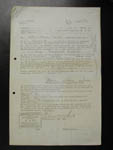
35 The bullet passed from right to left markedly upwards and forwards, enters the right abdominal cavity where it transfixes and mutilates the right kidney, transfixes the right lobe of the liver, transfixes diaphragm, transfixes the lower lobe of the left lung, transfixes sibson fascia on the left, lacerates the left common carotid artery and emerges through wound no. (2).24
The meticulousness with which the body of this first casualty of the uprising was tracked through the bureaucracy of death leaves no doubt as to his identity or to the capacity for painstaking exactitude of procedure on the part of the responsible authorities. This must of course raise grave suspicions about the frequency with which so many bodies disappeared temporarily or permanently and suggests deliberate procedure rather than mistake or confusion.
Even the concrete evidence contained in post mortem documents was violently manipulated to give it a different meaning and to bend it to the discursive purposes of the state. Before the Cillié Commission, Bukofzer would comment that this "does not look like a … ricochet shot. This is a direct … shot… It was a very long and angled shot." The curious angle of the bullet's path—"This was an entry of the back and exit on the other side, the neck, and this shot must have been at a great angle in an upwards direction, going from the right to the left side"—led Bukofzer to hypothesize that if Hector Pieterson had been standing up
… that shot came from below. It the person was lying down at the time, it could have come from the same plane or also slight upwards. But this sort of shot is where I think the gun was held well below to the level where the person was standing… If he was lying down, it could have been really at any angle, but probably at the same level, similar level.25
Could Hector Pieterson have stumbled and fallen as he ran from the first volley of gunfire? Advocate van Graan suggested another possibility
40… as to the position of the deceased. Was it perhaps possible that he was in a bending position when he was shot?Bukofzer: Yes, we must accept that as a possibility. Bending forward.26
It is what was not said here that is important. Van Graan suggested that the boy had been bending over to pick up a stone to throw at the police, who had therefore had good cause to shoot him. This suggestion echoed later attempts by the Cillié Commission and other spokesmen of the government to try to prove that the police had opened fire only after the students had begun throwing stones, thus seriously threatening the lives of the policemen. Such attempts by the state to manipulate or obfuscate the evidence, to cling to a high ground or to create confusions of causality, were deliberate maneuvers to obscure the inappropriate deadly force with which the police fired on students, even if they were throwing stones. Such reckless application of deadly force meant that Hector Pieterson "died very quickly with this damage… Artery, liver. The liver was mutilated. The liver and the kidneys were mutilated and went to pieces. He would not have lived very long."27 The facts of Hector Pieterson's death, the exact circumstances, will always remain inaccessible, no matter how numerous the records and recordings of memory. Too many different political agendas converged to create public memories that were, ultimately, constructed around blind spots and silences.28 Memory can only partially excavate this silence, but what we do know is that Hector Pieterson was shot in the back and that he died.
The clinical language of post mortems and inquests was scientific, precise and remote. It nevertheless conveyed the terrible violence of this death, as of so many others. I quote these reports extensively to retrieve from the historical record some sense of the terrible destruction wrought by the police in the townships. Each of these victims became a statistic, a short entry in the long lists of the dead that stood silent testimony but revealed little of the person or of the story of his or her death. But the secrets can be wrested from the statistics by reading them against the historical record of autopsy reports. However harsh these medical juridical descriptions were, they gave each death a human face and substance. Here, they retrieve the person from the silent historical record and lay bare the grim details of the circumstances of his or her death. Godfrey Mahapo, a "scholar," died from a "bullet wound through both lungs and thoracic aorta: Haemorrhage.—not established where or in what circumstances inflicted."29 He was 13, lived in Alexandra township, and died on June 18, 1976. There was no alcohol found in his blood. Shadrack Kekane died of a "gunshot wound of chest." He was 12 years old. An inquest could not establish under what circumstances the wound had been inflicted. Post mortem testing found no alcohol in his blood.30 Lele Ida Thobejane, for whom there was no known address, also died on June 18, 1976, in Alexandra township, from a "gunshot wound of chest," for which it could not be "established where and in what circumstances [it had been] inflicted." She had been a housewife and was 31 years old. Her husband, Mokonko Daniel Tobejane, remembered having given her five Rands that morning so that she could buy milk for their two-month old twins.31 Florence Magadani was 16 when she died of a "gunshot wound of abdomen and chest."32 Lawrence Serobe, 17, died on August 9, 1976, in Alexandra, of a "[g]unshot wound of abdomen … whilst riotously assaulting the police—homicide—anaesthesia and surgery competent." From the last phrase it was clear that at least some attempt was made to save this young unemployed black man's life. In some cases the inquests ruled that death was not "brought about by any act of omission involving or amounting to an offence on the part of any person." In most, the magistrate noted that he was "unable to make a finding."33 Nomvula Cecilia Nokwana was 13 when she died of "multiple injuries"—the post mortem hypothesizes "bus ongeluk" (bus accident). In this case, Magistrate H. E. Thompson ruled that the death had indeed been brought about by either an act of omission or an offence "by an unknown person or persons."34 Victor Mkwanazi identified the body of 17-year-old Lindiwe Mkwanazi on July 1, 1976, four days after she died of "peritonitis following gunshot wound of abdomen."35 Amos Mokoena, 14, was an "adult youth" according to the post mortem examination of his body by principal district surgeon Hans Bukofzer. He died of a "gunshot wound of lung" on June 18l 1976. The post mortem report describes the following:
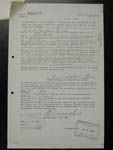
1. A 4cm x 2cm bullet exit wound on the left supra clavicular fossa close to the midline.
2. A 5cm x 3cm bullet exit wound the left upper lateral thigh.
3. Dry grey paint in the hair.
4. A 8mm bullet entrance wound on the right buttocks in upper quadrant.
5. A 9mm bullet entrance wound on the right lateral chest wall, overlying the 4th interspace, over the posterior axillary line.
TRACK WOUND (4): From right ot left, forwards and slightly downwards, through the tissues of the right inner buttocks, through the left buttocks and emerges at the exit wound (2). No vital tissue involved.
TRACK WOUND (5): From right to left, upwards and forwards, enters the right chest cavity by transfixing the 8th rib, transfixes the right upper lobe and … apex of the left upper lobe, shatters the left clavicle and 1st rib, emerges through wound (1).36
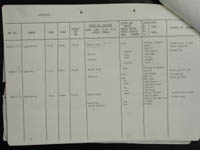
In some cases, even this most factual of information was exploited by the spokesmen of the government to prove the criminal and delinquent
behavior of those whom it had killed. I have described elsewhere how it was in the interest of the state to show that alcohol had been abused
by the participants in the uprising following the large-scale looting and destruction of the beer halls and bottle stores in the townships,
making them more violent and destructive and casting doubt on their courage and integrity. This was the reason blood tests were performed on
all victims. (See essay: "Beer Halls and Bottle Stores.") There were other such examples. Frank Mbebe, 16, died of
gunshot wounds to the abdomen and buttock. The post mortem examination report mentioned that his "right lower leg [was]
covered in white paint."37
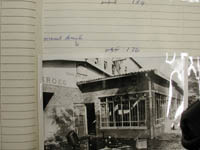 Oormaat drank (excessive alcohol) annotated by the police
Nineteen-year-old "adult, bantu, male" Raymond Mahlanza was killed
from the back by a "gunshot wound of abdomen, omentum and aorta." Again, the post mortem investigation listed "[g]reen paint on the left hand
and forehead and white paint on the lower back" in its description of the external appearance of the body.38
An exchange between Advocate van Graan and Dr. Bukofzer revealed the importance of this finding:
Oormaat drank (excessive alcohol) annotated by the police
Nineteen-year-old "adult, bantu, male" Raymond Mahlanza was killed
from the back by a "gunshot wound of abdomen, omentum and aorta." Again, the post mortem investigation listed "[g]reen paint on the left hand
and forehead and white paint on the lower back" in its description of the external appearance of the body.38
An exchange between Advocate van Graan and Dr. Bukofzer revealed the importance of this finding:
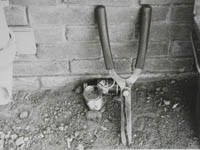
If I am allowed to give hearsay evidence? … I mentioned this fact of the paint being present on the body to I think it was Captain Engelbrecht, Soweto Police. He asked us to record these findings very carefully as he considered this to be of great importance because a number of the rioters who were shot, were busy firing buildings and they used paint, various paints to—as an inflammatory material. They would use the paint to cause a big fire. This is what I was told and I realise this could be of importance in these findings.39
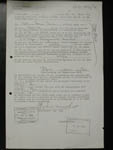
There was an 8-year-old child, Lilly Mithi, who died from a gunshot wound to her heart. Bukofzer performed a post mortem investigation.
Then there was 12-year-old Hermina Leroke, who died from a gunshot wound to the chest: "The track of this wound passes from
the back to the front and these are the only two wounds."
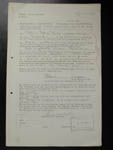 Autopsy Report - Hermina Leroke
In response to accusations—they were made by Tsietsi Mashinini in The Guardian on October 5, 1976—of excessive and random violence on
the part of the South African Police, Bukofzer was clearly relieved to be able to report in both of these cases that these were "the only injuries
found on that child [Mithi] and it certainly was not a case which was riddled with bullets; it had one shot" and that Leroke's body was "certainly
not riddled with bullets."40 In a statement procured by the police after Mashinini's article appeared
in The Guardian, Onica Mithi, the child's mother, said:
Autopsy Report - Hermina Leroke
In response to accusations—they were made by Tsietsi Mashinini in The Guardian on October 5, 1976—of excessive and random violence on
the part of the South African Police, Bukofzer was clearly relieved to be able to report in both of these cases that these were "the only injuries
found on that child [Mithi] and it certainly was not a case which was riddled with bullets; it had one shot" and that Leroke's body was "certainly
not riddled with bullets."40 In a statement procured by the police after Mashinini's article appeared
in The Guardian, Onica Mithi, the child's mother, said:
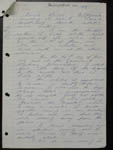
On 17/6/76 at approximately 12 noon … I was near the Diepkloof Hotel, accompanied by my daughter Lilly and Martha, my cousin. I was walking towards the hospital when I saw a number of bantu-youths running in our direction. I looked and saw that they were running away from the police. I heard shooting and we started running as I was scared of being accidentally shot. As we were running I saw Martha falling and I then noticed that Lilly was also down. What actually happened was that Martha was wounded in the leg and whilst tending her, Lilly was shot. The police arrived and removed Lilly, who in my opinion was dead… Lilly was shot by police in a big white lorry and there was no vehicle, known to me as a "hippo" in the vicinity. I do not know why the police were shooting at the fleeing bantu youths and I think that Lilly was shot accidentally. She never gave the "blackpower" sign and was actually part of a crowd when she was shot.41
It was clear from the last three sentences that police questioned Onica Mithi with the purpose of establishing that Lilly had not been the victim of the "[police] vehicles called hippos, which have guns sticking out at every angle" and that her death had been accidental.42 In the end, though, such strategies were futile in their attempt to diffuse blame. There was no big difference between shooting a girl as an innocent bystander while aiming at someone else in a crowd—an accident, as the state would have had it—and shooting her on purpose. The recklessness and wanton disregard for the risk inherent in shooting directly into a crowd that, by definition, would have included children and innocent bystanders made this death as deliberate as if the police had targeted her on purpose. This use of deadly force against students running away amounted to criminal liability.
Notes:
Note 17: Sophie Tema, testimony, 21 September 1976, SAB K345, vol. 139, file 2/3, part 1, Commission Testimony vols. 9 and 10. back
Note 18: Kleingeld also killed Hastings Ndlovu, who died from a gunshot wound to the forehead. His father, Elliot Ndlovu, remembered how the police had tried to convince him that the death had been an accident, caused by a ricocheting bullet. He told the police he thought they were not telling him the truth. Ndlovu remembered how he told Kleingeld, "I forgive you, but I will not forget. I told him, I even said [to] him, If I can meet you, I can kill you with my bare hands." Elliot Ndlovu, in Two Decades … Still, June 16, film produced by Loli Repanis, directed by Khalo Carlo Matabane, for SABCTV, 16 June 1996. back
Note 19: Johannes Augustinus Kleingeld (Lieutenant Colonel, South African Police, Orlando), second testimony, 27 September 1976, SAB K345, vol. 140, file 2/3, part 3, Commission Testimony vol. 15, pp. 584-628. back
Note 20: Johan Petrus Fourie (sergeant, South African Police), sworn statement according to Act 56 of 1955, article 239(4), as amended in Act 96 of 1955, SAB K345, vol. 99, part 4. back
Note 21: C. J. Bornman (sergeant, South African Police), sworn statement according to Act 56 of 1955, article 239(4), as amended in Act 96 of 1955, SAB K345, vol. 99, part 4. back
Note 22: Dorothy Pieterson, Identification of Body, document of South African Police, SAB K345, vol. 99, part 4. back
Note 23: Report on a Medico-Legal Post-Mortem Examination, Post-mortem report 2492/76, Department of Health, SAB K345, vol. 99, part 4. back
Note 24: Report on a Medico-Legal Post-Mortem Examination, Post-mortem report 2492/76, Department of Health, SAB K345, vol. 99, part 4. back
Note 25: Hans Bukofzer (principal district surgeon, Johannesburg), testimony, 13 October 1977, SAB K345, vol. 141, file 2/3, part 5, Commission Testimony vol. 26, pp. 1182-89. back
Note 26: Ibid. back
Note 27: Ibid. back
Note 28: Brink, "Stories of History," 37. back
Note 29: Summary of post-mortem report 2617/76 and inquest no. 1624/76 into Godfrey Mahapo's death on 18 June 1976, SAB K345, vol. 99, part 4. The inquest is dated 20 June 1977, as are five others—approximately one year after the death occurred. back
Note 30: Post-mortem report 2615/76 and inquest 1619/76, 20 June 19/77, SAB K345, vol. 99, part 4. back
Note 31: Post-mortem report 2557/76 and inquest 1628/77, 20 June 1977, SAB K345, vol. 99, part 4. Mokonko Daniel Thobejane, statement, 2 August 1976. SAB K345, vol. 99, part 4. back
Note 32: Post-mortem report 2607/76 and inquest 1622/76 (Florence Magadani, d. 18 June 1976, in Alexandra Township), SAB K345, vol. 99, part 4. A note on the edge of this document reveals that this name appeared both in the Rand Daily Mail of December 31, 1976, and on a "Church organisation list." SAB K345, vol. 99, part 4. back
Note 33: Post-mortem report 3882/76 and Inquest 2849/76 (Lawrence Serobe, d. 9 August 1976, Alexandra Township), SAB K345, vol. 99, part 4. No blood test performed. back
Note 34: Post-mortem report 2616/76 and inquest 153/76, 12 November 1976 (Nomvula Cecilia Nakwana, d. 18 June 1976, Alexandra Township), SAB K345, vol. 99, part 4. back
Note 35: Post-mortem report 2887/76 and identification of body, 1 July 1976 (Lindiwe Mkwanazi, d. 28 June 1976). back
Note 36: Post-mortem report 2585/76, 13 August 1976, SAB K345, vol. 99, part 4. back
Note 37: Post-mortem report 2581/76, 4 August 1976, performed by Prof. J. J. F. Taljaard, SAB K345, vol. 99, part 4. back
Note 38: Post-mortem investigation 2579/76, 6 August 1976, and identification of body SAP, 377, SAB K345, vol. 99, part 4. back
Note 39: Hans Bukofzer, testimony, 13 October 1977, SAB K345, vol. 141, file 2/3, part 5, Commission Testimony vol. 26, p. 1189. back
Note 40: Ibid., 1186-88. back
Note 41: Onica Mithi, statement to the police, 6 August 1976, SAB K345, vol. 190, part 4, exhibit 129. back
Note 42: Tsietsi Mashinini, statement at news conference organized by the Anti-Apartheid Movement, quoted in The Guardian, 5 October 1976, cited in SAB K345, vol. 141, file 2/3, part 5, pp. 1185-86: "The death toll has been given to you as 176, that is a blatant lie. We went to the mortuary each day and managed to read the numbers which were being put on the foreheads of the people who had died. I saw these numbers going up to 353 and that was after the first three days of shooting… They [the police] were moving around in vehicles called hippos, which have guns sticking out at every angle. An 8 year old girl was standing there not knowing what this hippo was all about. As it passed, this kid raised her fist in the Black Power salute. The hippo stopped and opened fire on the child. On the Saturday we went to the mortuary and found the body of the little girl and found the body riddled with bullets." back
